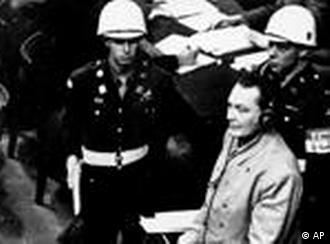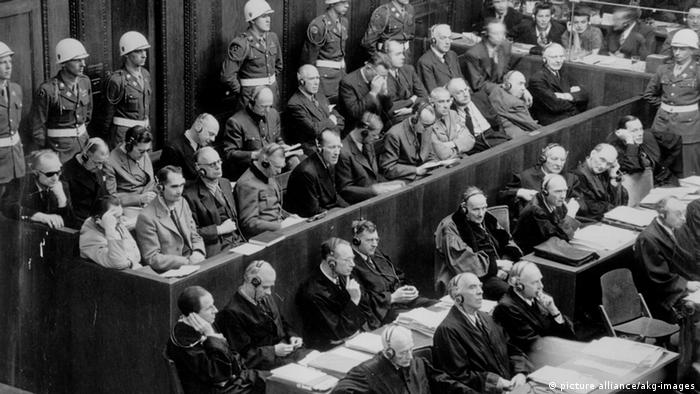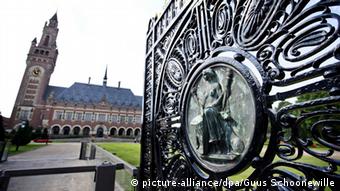The Nuremberg trials were a series of military tribunals, held by the Allied forces afterWorld War II, most notable for the prosecution of prominent members of the political, military, and economic leadership of Nazi Germany who allegedly planned, carried out, or otherwise participated in The Holocaust and other war crimes. The trials were held in the city of Nuremberg, Germany.
The first, and best known of these trials, described as "the greatest trial in history" byNorman Birkett, one of the British judges who presided over it,[1] was the trial of the major war criminals before the International Military Tribunal (IMT). Held between 20 November 1945 and 1 October 1946,[2] the Tribunal was given the task of trying 23 of the most important political and military leaders of the Third Reich, though one of the defendants,Martin Bormann, was tried in absentia, while another, Robert Ley, committed suicidewithin a week of the trial's commencement. Not included were Adolf Hitler, Heinrich Himmler, and Joseph Goebbels, all of whom had committed suicide in the spring of 1945, well before the indictment was signed.[3]
The second set of trials of lesser war criminals was conducted under Control Council Law No. 10 at the U.S. Nuremberg Military Tribunals (NMT), which included the Doctors' Trialand the Judges' Trial. This article primarily deals with the IMT; see Subsequent Nuremberg Trials for details on those trials.
Contents
[hide]On 20 April 1942, representatives from the nine countries occupied by Germany met in London to draft the "Inter-Allied Resolution on German War Crimes". At the meetings in Tehran (1943), Yalta (1945) and Potsdam (1945), the three major wartime powers, the United Kingdom, United States, and the Soviet Union, agreed on the format of punishment for those responsible for war crimes during World War II. France was also awarded a place on the tribunal. The legal basis for the trial was established by the London Charter, which was agreed upon by the four so-called Great Powers on 8 August 1945, [15] and which restricted the trial to "punishment of the major war criminals of the European Axis countries"
紐倫堡審判的深遠意義
1945年,納粹德國戰敗後,盟軍在紐倫堡對戰犯進行了審判。這場審判對國際法也形成了重大影響。紐倫堡大審判的法律依據則是整整70年前,1945年8月8日同盟國簽署的《倫敦憲章》。
(德國之聲中文網) 從國際合作的意義上而言,紐倫堡大審判可謂是開創了國際立法的新紀元。這場審判的法律基礎便是當時理念相當超前的《倫敦憲章》,它規定了軍事法庭的審判流程。
1945年11月24日,22名被告步入紐倫堡中央法院;他們被指控犯有前所未有的暴行。這些被告都是納粹高層人物,在此之前,他們被拘禁在盧森堡的一座城堡內。
這22人此時並不清楚接下來具體會發生什麼。他們中有人猜測自己會立刻被送上絞刑架,而還有人則覺得被拘捕本身就已經是一種侮辱。納粹德國的議會主席、空軍司令、曾經被希特勒指定為接班人的戈林(Hermann Göring)就曾對外界表示,他完全無法想像他會被列入戰犯名單。
對於這場審判而言,一切的法律基礎、起訴依據、罪行適用都必須從零開始構建。歷史上還從來沒有過如此規模的審判。

被告席上的赫爾曼·戈林
國際司法的巨大進步
愛沙尼亞塔爾圖大學的國際法教授邁科索(Lauri Mäksoo)指出,紐倫堡大審判以及《倫敦憲章》有著重要而超前的意義,"這對今後界定國際法犯罪有著極其重要的影響,比如'反人類罪'這一概念就是當時創立的。"
為了達成大審判的法律基礎《倫敦憲章》,歐洲戰場的四個戰勝國進行了為期6週的艱苦談判。談判是圍繞著一張巨大的正方形桌子進行的,四個國家都能派遣相同規模的代表團。
儘管主持談判的東道主英國,但真正的推動者毫無疑問是美國。後者最初提議要讓納粹高層接受法庭審判。而英、法、蘇三國則傾向於直接處死納粹高層。1943年德黑蘭會議期間,斯大林據傳就曾建議將5萬名納粹高層集中起來統統槍斃。
對於美國、尤其是對於充滿理想主義情懷的傑克遜大法官(Robert H. Jackson)而言,建立國際法庭審判犯下暴行的戰犯是一個歷史性的機遇。傑克遜在致函美國總統杜魯門時寫道:"按照法律原則來處置戰爭犯罪行為,正當其時。"
一場審判,兩種法系
不過,審判首先遇到的一個重大難題便是法律體系的不同。英美採用判例法系,而法國與蘇聯以及包括德國在內的大多數歐陸國家則採用成文法系。究竟是應該按照英美法系,由檢察官來負責收集證據,還是應該按照大陸法系,由一個獨立工作組來收集證據供控辯雙方使用?法官應該有多大的權力?庭審的辯論流程又應該參考哪個法系?
和納粹的暴行相比,這些問題看似細枝末節,但也彰顯了戰勝國之間的互不信任,預示著冷戰的鄰近。來自美國的首席檢察官傑克遜就常因一些法律問題與蘇聯法官尼基琴科發生爭執,雙方都認為對方別有用心。
理想與現實
不過,最終四國依然達成了共識,簽署了《倫敦憲章》。同盟國將以四項罪名起訴22名納粹戰犯:反和平密謀罪、侵略計劃及實行罪、戰爭罪、反人類罪。
首席檢察官傑克遜原本還想將戰爭定義為普遍罪行,並且認為紐倫堡審判的法律基礎今後也應該適用於所有國家。不過,傑克遜的理想並沒有實現。紐倫堡大審判最終是由軍事特別法庭進行的,僅用於審判納粹戰犯。就和今天一樣,國際法並不能擺脫現實政治的影響。國際法教授邁科索指出,如今的海牙國際法庭,時常面臨的一項批評便是:它從來沒有審理過美國或者俄羅斯的戰爭罪行,"所以如今的問題依然是:這些法律對大國也適用嗎?事實上並沒有。"
人性被視作法理原則
不過,儘管受到了現實政治的干擾,1945年《倫敦憲章》的意義依然不容輕視。德國歷史學家、法學教授穆勒(Ingo Müller)認為,《倫敦憲章》是文化上的巨大進步。他指出,戰後的德國也並非一直能夠接受《倫敦憲章》的理念,"尤其是當時德國的法律界人士,他們對紐倫堡大審判頗有意見。"穆勒對德國之聲表示,德國司法機關一度不承認紐倫堡大審判的結果,以至於納粹戰犯刑滿釋放後,被德國司法機關認定為沒有犯罪前科,能夠全額領取軍人養老金,坐牢期間的養老金還獲得補發。
不過,穆勒也指出了紐倫堡大審判的積極意義:"國際法能夠得到落實。"穆勒說,儘管美國、中國這樣的大國如今並不把海牙國際法庭當一回事,"但是,我認為,國際法庭依然影響了世界對良知的認識。"


沒有留言:
張貼留言